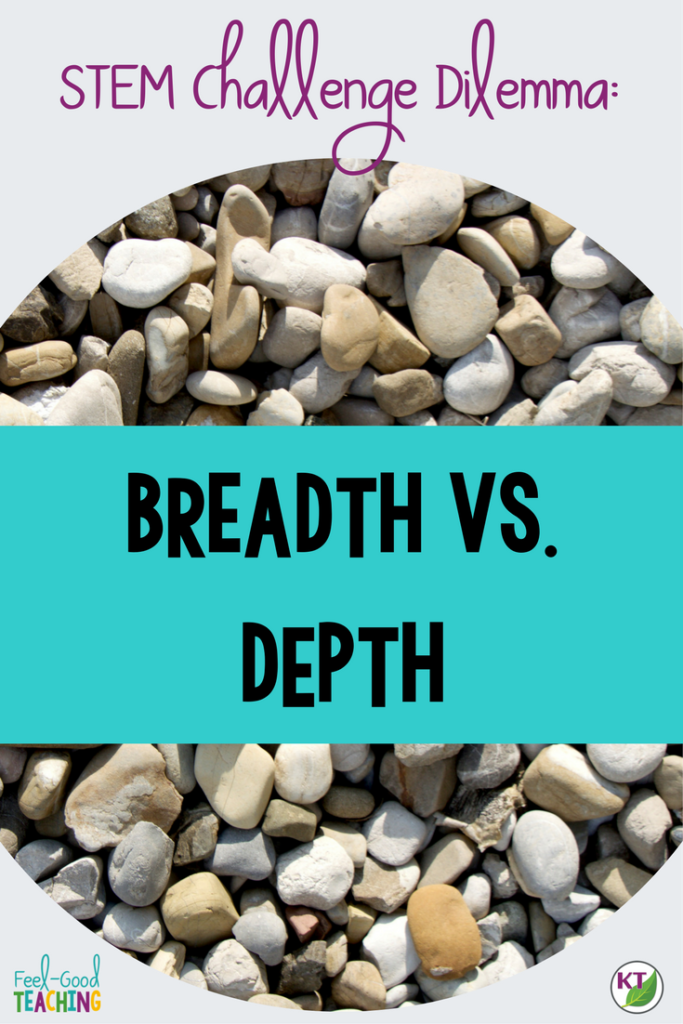Time is a precious, precious classroom resource. We are forced to make concessions and compromises to all the wonderful lessons, projects, and labs we know will enrich our students!
With that in mind, when it comes to STEM Challenges, what should be our focus: breadth or depth? I share my thoughts in the video below. As always, if you prefer reading to viewing, you’ll find the transcription beneath the video.
Watch Me!
Video Transcription
Hi, I’m Kerry from Feel-Good Teaching and today we’re talking breadth versus depth. Is it better to do many different Stem challenges or fewer but to go deeper into the process? And the answer is, drum roll please, yes. Oh great, another unrealistic classroom expectation for me to meet. Not to worry, I am not piling more on your already very full plate, just give me a chance to explain. I often liken the engineering process to writing the process. So if you think about in your classroom the difference between quick writes and going through the entire writing process. Both are very valuable, right? But they serve different purposes and they have different benefits. And you probably shouldn’t choose one over the other. You should try to go for a mix or a balance of both.
And translating that into STEM challenges, breadth would be lots of one off challenges, where the students have just one chance to go through a particular challenge. Whereas depth would be sticking with one STEM challenge for maybe two or three iterations, maybe even more. And just like with writing, both approaches have value and different types of benefits. So you do want to try to figure out how to mix the two. If in your classroom every assigned writing piece went through the entire writing process, well you’re probably going to find that exhausting and so will your students. And frankly, some of them might get bored by that. So you want to break it up with a couple of quick writes, right?

On the other hand, if all you ever did was quick rights, how do you think that would impact your students’ development of their writing skills? Probably pretty negatively, right? It’d almost be by accident or even a miracle if their writing skills improved dramatically using just quick writes. The same is true of the engineering process. If we want students to develop that deep analytical thinking and taking failures and moving those into eventual successes, well we have to move them through the entire engineering design process and that means doing a single challenge more than once. Because the process is where the deep learning happens.
But obviously you only have so much time in your schedule to devote to STEM challenges, so what you need to do is find a pattern that works well for you. I would recommend doing something like one in depth challenge followed by two, maybe even three quick one off challenges and then just repeat that cycle as it works in your schedule. And even when you do one off challenges, you can encourage students to go further in depth by making it an option in a maker space to do a second iteration or perhaps centers for early finishers, extra credit or homework.
To recap, the most important goal that we’re trying to serve by doing STEM challenges in our classroom, things like learning from failure, analyzing and applying data, developing growth mindset and resilience. These things are really only served by going in depth into the engineering process. One off challenges do not serve those goals nearly as well. But that doesn’t mean they’re without value. You certainly get with one offs lots of quick practice with engineering skills and principles, more opportunities for standards based connections in many different areas and the novelty is almost like cleansing the palette for you and the students. And It just adds a little bit of fun and variety to what you’re already doing.
So yes, you’ve kind of got to do both but that doesn’t mean you need to devote more time to STEM challenges than you already are. You just need to vary your patterns for breadth versus depth. And if you’re struggling to find time to do STEM challenges at all in your classroom, I did make another video on just that very topic. You’ll find some quick tips and some sample schedules that could help you out in your situation. Definitely check that out. I will link it below.
How often are you doing STEM challenges in your classroom? Do you already have a pattern for breadth versus depth? Let me know in the comments. Or even reach out and join Stellar STEM Teachers Facebook group and we can continue the conversation there. Make sure you’re following and subscribe and as always, I truly hope your week has been packed with feel good teaching moments. See you next time.



